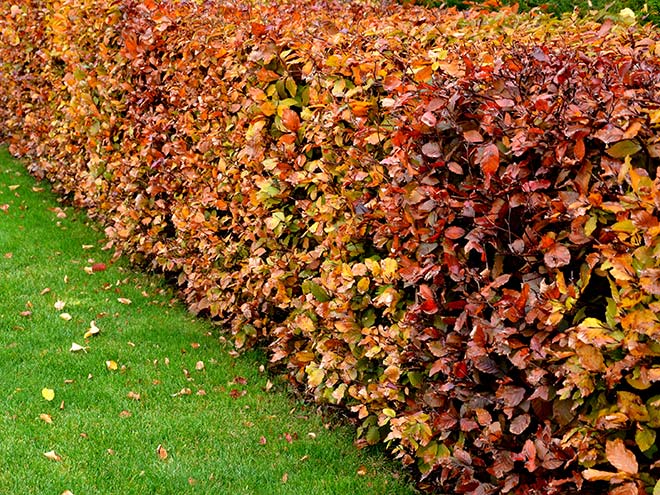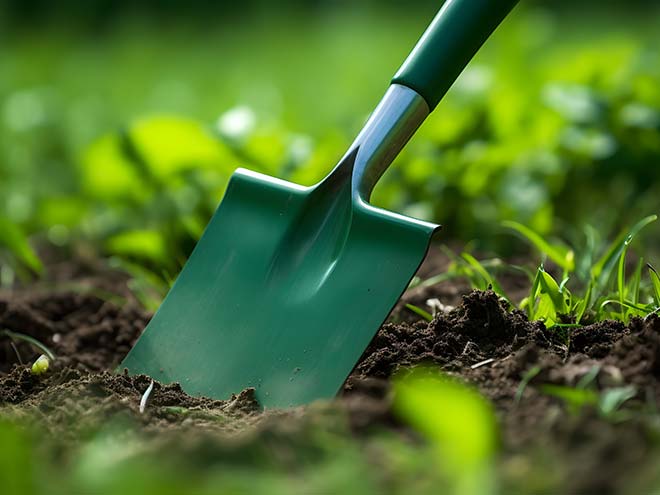Beech Hedging, is one of the most popular hedging species due to its display of wonderfully bright green or purple, wavy foliage that turn stunning shades of coppery orange in the autumn.
Beech hedge plants provide all year round interest in the garden and consist of Fagus sylvatica, also known as Green Beech and Fagus sylvatica 'Purpurea', also known in the UK as Purple Beech or Copper Beech.
Choose from our most popular varieties of Beech Hedging plants, available in a range of sizes and root types.
Beech is a popular deciduous hedge as it has superb dense bright green foliage with wavy edges, that turns copper in the autumn and is retained throughout the winter months.
Growth rate: Medium 20-40cm per year
Overall height: Tall up to 7.5 metres
Position: Full Sun, Full Shade
Root Types: Bare Root, Instant Hedging, Pot Grown
Purple or Copper Beech is a stunning deciduous hedge that has dark green to purple foliage with wavy edges, that turns copper in the autumn and is retained throughout the winter months.
Growth rate: Medium 20-40cm per year
Overall height: Tall up to 7.5 metres
Position: Full Sun, Full Shade
Root Types: Bare Root, Instant Hedging, Pot Grown
To learn more about Beech Hedging, take a look at our helpful Hedging Guides & FAQ's
Our team are on hand to help answer your questions!
info@hedgingplantsdirect.co.uk
Opening times
Monday - Friday : 7:30am - 4:30pm
Saturday & Sunday: 10am - 2pm
We are also open 10am to 2pm on bank holidays
We're trusted by throusands of happy customers, growing and supplying high quality hedging plants throughout the UK to retail and trade clients.
Plus we offer FREE DELIVERY on orders OVER £75
Click here to read our latest reviews.
Beech hedge plants are a staple of British landscapes, renowned for their vibrant foliage and seasonal versatility.
These hedging plants, distinguished as Fagus sylvatica (Green Beech) and Fagus sylvatica 'Purpurea' (Copper or Purple Beech), are celebrated for their wavy bright green or purple leaves that transition to beautiful coppery shades in the autumn.
Not only do Beech hedge plants form a dense, visual barrier, but they also create a haven for native UK wildlife.
Whether you're seeking to add a touch of elegance to your garden or craft a natural privacy screen, the dense foliage of Beech hedge plants are a delightful and practical choice.
Beech hedges are known for their moderate growth rate, typically growing about 30-60cm per year.
This steady growth rate ensures a sturdy and uniform hedge in a reasonable period of time without requiring excessive maintenance.

There are three main root types of beech hedge available in the UK.

Bare root beech plants are an affordable option, particularly suitable for larger planting areas. These plants are field-grown and delivered during their dormant period, typically between November and April.
Despite being cost-effective, the bare root method doesn't compromise the quality of your hedge.
These plants are easy to plant and readily establish themselves in their new environment. They are an excellent choice for those seeking to create a traditional hedge on a budget.

Pot grown plants offer a flexible, convenient solution for those looking to transform their landscape throughout the year.
These plants are grown in pots and nurtured to maturity, allowing them to be planted at any time, avoiding the limitations of the planting season.
The advantage of pot grown beech hedging is the intact root system which is preserved in the pot, promoting quick establishment and healthy growth after planting.

Instant hedging is an ideal choice for those desiring an immediate, mature hedge.
These units are grown for several years prior to purchase, meaning upon installation, your hedge appears fully formed and established.
Instant beech hedging is a perfect choice for those seeking immediate impact and a mature garden look.

For a step by step process and further information on how to plant beech hedges, please see our comprehensive hedge planting guide.
The best planting time for Beech hedges is between November and March, when the plants are dormant.
It's important to note that while they can flourish in most soil types, beech hedge plants prefer well-drained soils.
With the right conditions, your beech hedge should reach its full potential in 5-10 years, providing a remarkable display of colour and texture throughout the year.

The distance between each beech hedge plant depends on the root type and size of the plant.
Please refer to our Beech Hedge spacing chart below which contains the correct planting spacing and distances for each root type and plant size.
Beech hedges thrive best in well drained soil. They can adapt to a variety of soil types, including clay, sandy, and loamy soils, but may struggle in overly wet sites.
In terms of pH, Beech hedges are flexible and can grow in neutral, alkaline, or slightly acid soil. However, they do prefer slightly chalky soils if available.
As for planting positions, Beech hedges crave sunlight and therefore should be positioned in a place where they will receive full sun to partial shade.
They can handle exposure to wind but prefer sheltered or semi-sheltered sites to protect the foliage from damage.
It's also worth noting that Beech hedges planted in north-facing sites may lose more leaves in winter than those in sunnier positions. However, this is usually a minor issue and won't affect the overall health of the hedge.
An established hedge will tolerate hard pruning in August and trimming in early spring, but it's advised to give them a lighter trim in late summer to encourage retention of their leaves over winter.
For a comprehensive guide and tips on how to successfully prune your beech hedging, please read our Beech Hedge Pruning Guide.
Beech hedging plants are generally low maintenance and do not require frequent watering or fertilising. However, during their first year after planting, it's essential to provide adequate water to help establish the root system and promote new growth.
Water your beech hedge deeply once a week, ensuring the soil is thoroughly soaked. Reduce the frequency during rainy seasons to prevent water logging.
As for fertilising, an annual application of a balanced, slow-release fertiliser in early spring can boost growth and enhance the health of the hedge.
Spread the fertiliser around the base of the hedge according to the manufacturer's instructions and water well to allow the nutrients to seep into the soil.
Always remember to avoid over-fertilising as it can lead to excessive, weak growth and potential damage from pests and diseases.
Remember, while Beech hedge plants are generally hardy and adaptable, the key to their healthy growth lies in the combination of proper site selection, suitable soil conditions, and the right balance of watering and fertilising.
If you follow these tips you will have a beautiful dense hedge with striking winter leaves.
Yes, beech hedging is an excellent choice for a hedge. Their dense and symmetrical growth makes for attractive barriers and borders.
Their foliage is vividly coloured and changes throughout the seasons, offering year-round visual interest.
Additionally, this semi evergreen hedge is easy to maintain, requires moderate water, and is resilient against harsh weather conditions, making it a practical and aesthetically appealing choice for many gardens.
Beech hedges grow at a moderate and steady rate of approximately 30-60 centimetres per year.
With this steady pace, your beech hedge should reach its full potential and provide a remarkable display of colour and texture within a period of 5-10 years.
A Beech hedge typically turns green in the springtime when the new leaves start to sprout. This usually occurs around late April to early May, depending on the local climate.
The lush green foliage provides a vibrant display throughout the summer, before transitioning to delightful copper hues in autumn.
These leaves usually remain on the branches during winter, maintaining a semi-evergreen barrier until new green leaves replace them in the following spring.
The best species for beech hedging is the Common Beech (Fagus sylvatica). This deciduous beech tree is native to the UK and is treasured for its year-round aesthetic appeal.
The leaves of the Common Beech transform from a lush bright green in the spring and summer, to a warm copper in the autumn and winter.
Another popular choice is the Purple Beech (Fagus sylvatica 'Purpurea'), recognised for its captivating purple-copper foliage.
Both species create dense, beautiful hedges and are equally effective in providing privacy, reducing noise, and acting as windbreakers.